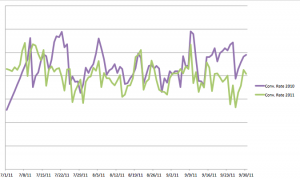
This report shows visits are up year over year. Yea! Well done everyone, the markting budget is paying off! Let’s keep the momentum going and see if we can continue to drive even more visits to the site!

This report shows conversion rate is down year over year. Boo! What the heck is going on everyone! Let’s optimize our accounts, cut cost per acquisition in all channels and limit non-qualified visitors entering the site!

The truth lies when you look at conversion rate on top of visits. Obviously, if you’re spending more on reaching out to drive more visitors to the site, chances are they are new visitors and not very low in the conversion funnel, causing a drop in conversion rate. Do you ask someone to marry you on the first date? No of course not, yet that is what too many companies expect when they pay to drive new traffic and expect them to purchase after their first interaction with the site.
What is a “good” conversion rate? Is less than 1% bad? Is greater than 7% amazing? Neither. It all depends on volume of traffic, average order value and margin. If you sell a product for $50 online, would you rather have a site that gets 100,000 daily visits and have a dismal looking conversion rate of .9%, or a site with an amazing conversion rate of 6% but gets 1,000 visits? Option one would be making $45,000 while option two makes only $3,000.
It gets dangerous when an organization has its mind set on a specific conversion rate and makes short term changes to maintain it – like managing their marketing channels so that only the most qualified and interested visitors come to the site. These visitors tend to be repeat customers already far down the conversion funnel – converting the converted. A healthy business will continue to invest in adding more new customers into top of the the bucket. If not, and the tyranny of maintaing conversion rate runs rampant, the amount of people leaking out the bottom of the bucket will exceed the amount going in the top. A target conversion rate should allow for a healthy amount of new visitors who are an investment in the long term. Today’s expensive, non-converting visitors are tomorrows cheap, high-converting visitors.